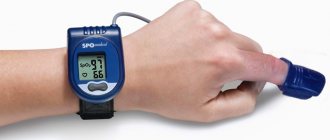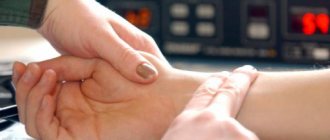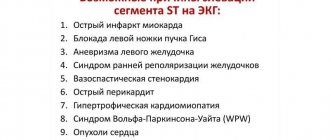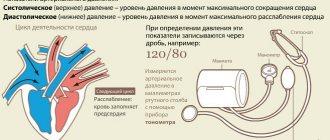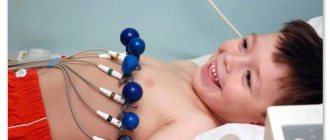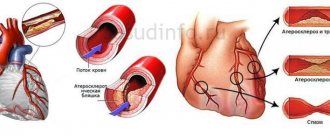What is the normal resting heart rate?
The rhythm of the heart, measured by the pulse, depends on the age, gender, body weight, and fitness of the person. The dynamics can be influenced by many factors: training and level of physical fitness, state of mind, illness, pregnancy, environmental factors, dehydration, overtraining, stress.
Therefore, heart rate (HR), that is, pulse, at rest is an individual thing, but there is an accepted physiological norm. For a healthy adult with a young body, this is 60-80 beats per minute.
In athletes with a trained heart, the resting pulse can drop to 40-50 beats per minute, and this will be their norm - the term “athletic heart” was coined for this.
And often the resting pulse refers to a narrower concept, namely the morning pulse - as soon as you open your eyes and before you get out of bed.
When does heart rate change?
As a rule, changes in heart rate are caused by physical activity and emotional stress.
However, a change in heart rate is often facilitated by a change in the climate of a person’s stay (a sharp change in air temperature, atmospheric pressure). This phenomenon may also be temporary due to the adaptability of orgasm to environmental conditions.
As an option for changing heart rate, you can also consider taking various medications and medications prescribed by a doctor when necessary for health reasons.
What can you understand by measuring your morning pulse?
If you regularly measure your pulse in the morning, for example, for a week, you can:
- get an idea of the body’s adaptation to stress;
- you can see how regular running, swimming, cycling, skiing - any cyclic sports - affect heart training;
- assess the quality of restoration;
- track the onset of overtraining;
- track the onset of the disease;
- understand the level of stress in life;
- understand how acclimatization occurs in the mountains (if you find yourself there).
Tracking athletes' morning heart rate is becoming an important marker for assessing training. Every serious athlete records their resting heart rate in a diary, which also displays their heart rate zones during training. These indicators are assessed by the trainer, since an increased or decreased heart rate may indicate problems, insufficient or excessive training volume.
And it is the pulse that is used as a guide when undergoing acclimatization in the mountains, be it training at altitude or climbing. After rising to a height, the body adapts to “pump” blood throughout the body in conditions of less oxygen supply and increased pressure. A morning heart rate returning to normal indicates that acclimatization has taken place and you can continue training or climbing.
Read on the topic: Pulse zones: what heart rate to run at
photo: Nastasic/Getty Images, source: runnersworld.com
How to measure resting heart rate
The best way to measure your resting heart rate to track your body's progress or detect any heart problems is to measure your heart rate immediately after waking up. That is, in the first moments when you opened your eyes and before you got out of bed.
- To measure your resting pulse after waking up, you need to slowly take a watch with a stopwatch and feel one of the arteries. You can measure the pulse on the radial artery (wrist), on the temporal artery (temple area), on the carotid artery (on the neck under the jaw on the right side), on the popliteal artery (the bend under the knee), on the brachial artery (inner side on the elbow) .
- Just count the beats for 15 seconds and then multiply the number of beats by 4 to get the beats per minute result. Or, to calm yourself, count for all 60 seconds.
- It’s easier to use wearable gadgets – a smart bracelet or a fitness watch. If you sleep with them on, the device will count your pulse while you sleep, which provides the most accurate data. At the same time, you can find out the frequency of breaths, intervals between beats, and heart rate variability.
- These same methods can be used during the day, but you need to take into account that the daytime resting pulse is higher than the morning one, exactly in the same physiological norm - 60-80 beats.
- The same methods apply if you lie down and rest for 10 minutes without moving. Then the resting pulse will be equal to the morning one.
Methods for Measuring Heart Rate
To determine whether heart rate corresponds to the norm, it must be measured at rest, several hours after eating a hot or protein meal, in normal health, in a quiet and warm (but not hot) room. About an hour before taking measurements, it is necessary to avoid smoking, stop drinking alcohol and taking medications, and eliminate significant physical and emotional stress and stress. The person being measured can sit or lie down and remain calm for five minutes.
To measure, an assistant places his palm on the chest: below the mammary gland in women or below the left nipple in men. It is necessary to take a stopwatch and count the frequency of contractions for a minute, and for irregular contractions - three minutes and divide the resulting number by three to determine the average.
Heart rate can be measured in other places, where the arteries come close to the surface. The pulsation is clearly palpable:
- on the neck,
- under the collarbone,
- at the temple,
- on shoulders,
- on the hip.
When measuring your pulse, to get more accurate results, you need to do it on both sides of the body.
What does resting heart rate depend on?
Resting heart rate is influenced by many factors. Some of them are objective:
- physical activity;
- floor;
- age;
- pregnancy and hormonal levels.
And less obvious factors:
- emotions;
- illness;
- dehydration;
- eating;
- acclimatization;
- change of time zones.
When they talk about these factors, they most often mean deviations from the norm of the resting pulse - its increase by 10-20 beats per minute and maintaining this state for some time.
How to correctly determine heart rate in men?
To measure heart rate, a man must be at rest and also be in a warm room . An hour before the procedure, it is necessary to eliminate physical and emotional stress, and not smoke. It is prohibited to use medications and alcohol. To measure, the patient lies down or sits down. After taking the required body position, five minutes should pass.
The assistant should place his palm on the surface of the chest slightly below the left nipple. You need to feel the heartbeat. After this, you need to turn on the stopwatch and start counting your heart beats for a minute. If an incorrect rhythm is observed, the time must be increased to 3 minutes.
Heart rate can be measured in those places where the arteries are visible on the surface and the pulse is felt, namely:
- on the neck;
- at the temple;
- on the thigh;
- on the shoulder.
To obtain more accurate results, the procedure must be performed on both sides of the body and compared.
Maximum heart rate in men
The maximum heart rate in men is the greatest number of beats the heart makes in a minute. Very often this value is used by athletes to know what maximum load can be used.
The maximum heart rate for men can be determined using the following formula:
- Maximum heart rate for men = 220 – age.
This value will not be extremely accurate, but approximate.
Resting heart rate in long-distance runners
The normal resting heart rate for a young healthy person is 60-80 beats per minute. But a different picture and a different norm is observed among long-distance runners and other athletes involved in cyclic sports - cycling, swimming, skiing.
Many amateur athletes, and even more so professionals, say that their resting heart rate is plus or minus 40 beats per minute, and for some endurance athletes, the heart rate can drop to 20-30 beats at night during sleep.
It is generally believed that a low resting heart rate is a sign of a trained heart, and indeed this is how the body’s normal adaptation to extreme loads manifests itself. In the case of this so-called normal adaptation, the low resting pulse compensates for the stroke volume of the heart.
And if at this moment the athlete does not complain of weakness, dizziness, fatigue, if training is not incredibly difficult and performance does not drop, then a low resting pulse indicates a trained heart, capable of making fewer beats while pumping the same volume of blood throughout the body.
But at the same time, a low heart rate at rest and especially during sleep can indicate poor heart function. In any case, regularly monitoring your resting pulse and reflecting on your general condition will help you decide whether it’s time to see a doctor or not, time to reduce your loads and review your training plan or not.
Heart rate measurement technique
The simplest way to measure the pulse is to palpate it.
There are several ways to palpate the pulse:
- On the radial artery (most often used),
- On the carotid artery,
- In the area of the left half of the chest.
The normal heart rate of an adult at rest is 60–80 beats per minute. To feel the pulse on the radial artery, place your index and middle fingers on your hand in the area of the palmar surface of the wrist joint at the base of the first (thumb) finger of the hand. The easiest way to feel the pulse is in the carotid artery, located on the front of the neck on both sides. When feeling the pulse on the carotid artery, gently touch it with your index and middle fingers. You should not press hard on the carotid artery, as this can cause a reaction in the artery receptors and a sharp reduction in the pulse. The carotid artery should be palpated on one side only. If you are doing this on the right side, use your right hand. If you probe the left artery with your right hand, you may inadvertently press on both arteries. As a result, the pulse value will be inaccurate: a person may even lose consciousness if you obstruct the blood flow in both arteries by pressing hard on them. In addition, the pulse can be easily determined by placing the heel of the palm on the left side of the chest at the top point of the heart.
You should not measure the pulse only with your index finger or thumb, as these fingers have their own pronounced arterial pulse, which can confuse you. As a result, the calculations will be incorrect. Heart rate accuracy plays a very important role in determining the load. The main errors in determining your pulse occur when you lose count, confuse the time frame, or measure your pulse incorrectly.
For more accurate measurements, the pulse must be measured for 1 minute. Everyone knows: the longer you measure your pulse, the more accurate the results. When measuring your heart rate for 60 seconds, the value will not change much unless you clearly record the first beat, the beat at the 30th second, and the beat at the 60th second. The error will be three strokes. However, when measuring the pulse for 10 seconds, if these beats are missed, the error will already be 18 beats (standard units of heart rate measurement are beats per minute, therefore, when measuring the pulse for 10 seconds, the results obtained are multiplied by six: 3 (error over 10 s) x 6 = 18).
Today, the method of calculating pulse using heart rate sensors (HR) is becoming more and more widespread. Heart rate monitors are computerized electronic digital devices. They are worn on the wrist like a watch, and sometimes such monitors are built into exercise equipment. The device constantly reflects the pulse, providing new information about the load on the body every few seconds. This method is preferable to pulse palpation, since the measurements here are much more accurate and do not require specific skills. Monitors make it easy to track your heart rate during exercise and recovery. In this case, you do not need to stop or slow down to measure your pulse - using the sensor, the pulse is measured much more accurately than by palpation.
How regular running, swimming, cycling, skiing affect your resting heart rate
Regular endurance training in sports such as running, skiing, swimming, cycling leads to athletic adaptation of the body and especially the cardiovascular system.
When engaging in cyclic sports, the amount of fat in the body decreases, cholesterol levels decrease, and the proportion of so-called high-density lipoprotein cholesterol increases - along with it, the ability to resist cardiovascular diseases increases.
In addition, the volume of the heart and lungs increases, and the blood vessels dilate. Particularly interesting metamorphoses occur with the heart. Its density increases, the muscle walls become thicker. In athletes, during physical activity, the heart beats less often, but stronger, which is associated with the increased volume (or capacity) of the left ventricle of the heart. This makes it easier for the heart to pump blood throughout the body with each beat, which leads to a decrease in resting heart rate.
A heart that has undergone such changes during adaptation is called “sports”, and this is a normal phenomenon when getting used to physical activity. Interestingly, this condition was previously considered a pathology.
Pathological causes of pulse changes
Groups of pathological conditions that can increase the pulse rate more than normal (100 per minute at rest):
- heart failure with almost any heart disease (ischemic heart disease, hypertension, previous myocardial infarction, heart defects, and so on);
- anemia of any origin;
- respiratory failure due to lung diseases (obstructive disease, emphysema and others);
- rhythm disturbances - paroxysmal tachycardia (in this case, an increase in heart rate occurs paroxysmally, but outside the episode it is normal);
- feverish conditions;
- hyperthyroidism.
A slowdown of the resting pulse of less than 55–60 per minute is characteristic of permanent blockades of the conduction system of the heart (sinoatrial and atrioventricular) of II–III degrees, and is also observed in some endocrine diseases, for example, hypothyroidism and adrenal insufficiency.
Particular mention should be made of such a rhythm disorder as a permanent form of atrial fibrillation (atrial fibrillation). This heart disease is characterized by absolute irregularity of the heartbeat, so the pulse rate differs at different times.
There are tachy-, brady- and normosystolic variants of the pathology. During tachysystole, when the average heart rate exceeds 100 - 120 per minute, the phenomenon of pulse deficiency is noted. Due to very fast heart contractions, the cavity of the left ventricle does not have time to fill well with blood; a very small blood volume is ejected into the aorta, which does not create a pulse wave. If you simultaneously listen to the heart and pulse, then heart sounds that are not accompanied by pulse beats will be detected periodically.
The bradysystolic form, on the contrary, is accompanied by an irregular but slow pulse. Sometimes, against this background, rhythm pauses occur, which can reach 2 seconds or more, accompanied by dizziness and fainting.
Normal heart rate at rest depending on age
The physiological norm of heart rate differs in people of different ages - from the first days of life to old age.
- For the first month of life, the lower threshold of normal heart rate is 110 beats per minute; for children in the first year of life – 100 beats per minute.
- In children under two years of age - 95 strokes.
- In children aged 2 to 6 years – 85 strokes.
- From 6 to 8 years old – 75 strokes.
- From 8 to 10 years – 70 strokes.
- Then there is a wide age category from 10 to 50 years - the normal heart rate is considered to be from 60 to 80 beats per minute.
- In older people, the heart rate is slightly higher - from 75 to 90 beats per minute.
Causes of tachycardia and bradycardia
Cardiac tachycardia is a special condition in which the contraction frequency exceeds 90 beats per minute. With this disease, a focus of excitability of the heart muscle occurs, in which nerve impulses are produced at high speed. This leads to an increase in ventricular contraction. The nature of the condition directly depends on the size of the lesion.
The causes of tachycardia are as follows:
heart failure;- left ventricular dysfunction;
- myocardial infarction;
- angina pectoris;
- cardiomyopathy;
Physiological causes may include emotional stress, physical activity, and congenital predisposition.
Bradycardia is a type of arrhythmia in which the heart rate is less than 60 beats per minute. For athletes, this indicator is the norm, but for an ordinary person it is a harbinger of some kind of violation.
Symptoms:
- weakness;
- loss of consciousness;
- the person breaks out in a cold sweat;
- dizziness;
- pain in the heart area.
Causes of bradycardia:
- neurocircular dystonia;
- neuroses;
- increased intracranial pressure;
- peptic ulcer of the stomach and duodenum.
- Myocardial infarction;
- Myocardid;
- Cardiosclerosis.
When myocardial pathways are damaged, some impulses cannot reach the ventricles, and bradycardia develops. The cause of bradycardia can be taking medications, also due to intoxication of the body. Age-related changes in the body lead to bradycardia. Very often the causes of bradycardia cannot be determined.
Resting heart rate in men
The resting heart rate of healthy young men and women differs by about 10 beats.
Firstly, the structure of the body is fundamentally different. Men, for example, have a larger blood volume - 65 ml per kg of body weight, and women - 60 ml per kg. The male heart is slightly larger in volume, which means it is capable of “pumping” a larger volume of blood in one cycle of work, and therefore makes fewer beats.
Secondly, men's maximum oxygen consumption is higher, which also affects heart rate due to its better ability to transport oxygen throughout the body through the blood.
The resting heart rate in men who engage in intense training can reach 50 beats per minute or even lower. This will be the norm of a “sports heart”. In a non-athletic healthy man, the pulse should be within the physiological norm - 60-80 beats at rest.
photo: Guido Mieth/Taxi/Getty Images, source: lifewire.com
How does heart rate differ from pulse?
Heart rate shows the number of contractions the heart makes per minute. The pulse shows the number of dilations of the artery per minute, at the moment the heart ejects blood.
Despite the fact that pulse rate and heart rate mean completely different categories, it is considered normal when these two indicators are equal.
When the indicators differ, then we can talk about a pulse deficit. Moreover, both indicators are important when assessing the health of the human body as a whole.
Resting pulse in women
In the female body, everything is somewhat more complicated. The resting pulse rate in women is usually higher than in men, and fluctuates in the mentioned range of 60-70 beats per minute, although in female athletes it can also reach 50 beats.
Resting heart rate in women is greatly influenced by hormonal levels, even within one menstrual cycle. In the first phase of the cycle, the oxygen capacity of the blood decreases, and, as a result, aerobic performance decreases. At this time, you can observe an increase in resting heart rate and heart rate during training by 10 beats.
Approximately the same thing happens in the third phase - physiologists studying the bodies of female athletes observed a sharp drop in performance and the achievement of maximum values of working oxygen consumption. In the final phase of the menstrual cycle, an increase in heart rate can again be observed due to vasoconstriction and increased blood pressure.
Further in a woman’s life cycle, the pulse rate is greatly influenced by menopause - the resting beat frequency becomes higher, somewhere around 70-80 beats. Pregnancy also changes the resting heart rate. At the beginning of pregnancy, the resting heart rate begins to rise, increasing by an average of 10 beats. By the third trimester - by 15 strokes. When determining what is normal for each woman, you need to build on knowledge of the resting pulse before pregnancy.
Menstrual cycle and running: is it possible to train on menstrual days?
Slow heartbeat in children and pregnant women
It is important to understand that the normal heart rate for children is different from the normal for an adult. So, the heart of a newborn beats at a speed of 100-150 times per minute, a child from 1 to 10 years old - 70-130. Low pulse in children has standard manifestations: malaise, dizziness, darkening of the eyes, loss of consciousness, convulsions.
Bradycardia in children in the vast majority of cases is congenital. The cause may be a heart defect, heredity, or problems during fetal development (lack of oxygen or increased bilirubin in the blood).
Sometimes the root lies in past infectious diseases. Bradycardia in a teenager is often associated with too rapid growth of the body, which is a temporary phenomenon.
Bradycardia during pregnancy deserves special attention. Most often, pathology occurs in a woman even before conception, which she must warn the doctor about. Throughout her pregnancy, such a woman is under observation, undergoing examinations using ultrasound and other devices more often than other women in labor.
Why is your resting heart rate high?
We figured out what is the normal heart rate at rest and what can be considered objective factors influencing it - this influence is not considered a deviation from the norm. But there are factors that cause the resting heart rate to increase and deviate from the norm. Such moments need to be recorded and probably corrected.
First you need to determine the reason for the change in resting heart rate (except for objective factors):
- If in the morning you record an increase in heart rate - 5-6 beats higher than usual - most likely, overtraining is approaching, and you are observing its early stage.
- A high resting heart rate during the day - 10 beats higher than usual - can also be a sign of approaching overtraining, and also a viral disease. You need to take your temperature and monitor other symptoms. With each degree of temperature, the resting pulse will increase by 10-15 beats per minute. During the recovery period after illness, your resting heart rate will also be higher than normal.
- Environment, namely heat. When the ambient temperature is high, your body temperature will also rise. The body strives to cool down, the blood vessels dilate, the heart beats faster, and the resting pulse becomes higher.
- Emotions. Excitement, for example, before a public speaking or exam, laughter at a great comedy, sadness and tears - all these things can briefly change the resting pulse, most often increasing it.
- More serious stress already affects the autonomic nervous system, which regulates the work, including the blood vessel system. Certain processes lead to changes in the functioning of the circulatory system, the release of cortisol and adrenaline. The body “tenses”, prepares for danger, and the heart rate rises.
- Many factors can cause your resting heart rate to fluctuate upward. Flights and transfers, sleepless nights, time zone changes, too much mental and moral stress, even working in a stressful, noisy environment.
- Eating. An increase in heart rate at rest within 10-15 minutes after eating is a normal physiological state, this is especially true when overeating. Plus, after eating, metabolism increases, so an increase in resting heart rate after eating is normal.
However, a noticeable and sustained increase in heart rate after eating is possibly gastrocardiac syndrome. This may indicate diseases of the gastrointestinal tract or endocrine system. It makes sense to pay attention to other symptoms and consult a doctor.
Decoding the indicator
Depending on the change in the number of systoles, several results are distinguished, which are defined in the following medical terms:
- Tachycardia is a significant increase in the number of systoles above normal. The maximum frequency can reach 200 beats per minute, which is a very dangerous condition and requires mandatory therapeutic correction. Before reducing this indicator with the help of medications, the doctor must determine the functional state of other organs and systems, and also find out the cause of tachycardia. Submaximal frequency may be a variant of the norm associated with increased activity of the body (after physical activity).
- Bradycardia is a decrease in the number of systoles below normal, which may be due to the influence of cardiac and extracardiac causes.
During Holter monitoring, the circadian index is necessarily determined, which is the value of cyclic fluctuations of the indicator. The circadian index is lowered in the presence of cardiac causes of changes in systolic frequency, and increased when there is excessive stimulation of the sympathetic part of the autonomic nervous system. Using the heart rate indicator, the doctor can make a preliminary conclusion about the nature, nature and localization of functional or organic changes in the body. Also, depending on the severity of changes in the indicator, he can make a prediction regarding further changes in the functional state of the heart.
Pulse during overtraining
Separately, we need to dwell on the topic of resting pulse during overtraining.
It was said earlier that if in the morning an increase in heart rate of 5-6 beats per minute is recorded, this means that overtraining is approaching or has already occurred. Exactly the same story with a very low resting heart rate - for example, 25 beats per minute. This is also a symptom of overtraining.
Read on topic: Overtraining in running: 10 symptoms of insufficient recovery
Imagine, your heart beats at a rate of actually less than one beat every 2-3 seconds. This is not the norm, and too low a resting heart rate, as well as too low or high heart rate during training, are symptoms of overtraining. Excessive loads during intense training have led to this, and this suggests that the training program needs to be reconsidered.
Additional rest will make more sense. You also need to consult a doctor or trainer if your resting heart rate becomes unstable. This is especially true when accompanying symptoms of overtraining appear - dizziness, weakness.
Maximum heart rate
This is the highest number of beats per minute that the heart can make. This indicator is used by athletes to know what maximum load the heart can be subjected to.
It is best to determine the maximum heart rate clinically, that is, this should be done by a cardiologist using a treadmill and an electrocardiograph.
There is another simplified way to find out the capabilities of your heart, but the result will be approximate. Maximum heart rate is determined by the formula:
- for men – 220 minus age;
- for women – 226 minus age.
High resting heart rate: what to do
When the resting pulse is elevated and this is not due to objective reasons (age, gender, etc.), you can try the following:
- Quickly calm down or cool down by drinking a glass of cool water and doing breathing exercises - for example, inhaling deeply for 5 seconds and exhaling for 3 minutes.
- If the increase in heart rate is associated with emotions, try the psychological method of “grounding.” You need to get up and walk around the room or on the street, concentrating on momentary sensations, such as your foot touching the ground, and on what you see around you.
- A high morning heart rate indicates under-recovery - you need to get better sleep and reduce stress.
- If your heart rate has dropped or risen due to overtraining, rest and change your training plan.
- A resting pulse that is too low may indicate bradycardia, while a resting pulse that is too high may indicate tachycardia. Only a doctor can recognize and solve these problems.
Read on topic: Running at low heart rate: how and why to train at low intensity
